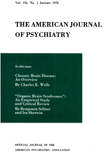NONCONVULSIVE ELECTRIC STIMULATION THERAPY
Abstract
Convulsive treatment through frontal leads inhibits respiration temporarily; nonconvulsive treatment through frontal or temporopariental leads stimulates respiration.
Convulsive treatment through frontal leads relieves depression but reduces awareness for memory content and may enhance anxiety, while nonconvulsive treatment through temporoparietal leads relieves anxiety and restores awareness for memory content, but may enhance depression. By using both, it is possible to avoid the "untreatable" residual after electroshock treatment.
Access content
To read the fulltext, please use one of the options below to sign in or purchase access.- Personal login
- Institutional Login
- Sign in via OpenAthens
- Register for access
-
Please login/register if you wish to pair your device and check access availability.
Not a subscriber?
PsychiatryOnline subscription options offer access to the DSM-5 library, books, journals, CME, and patient resources. This all-in-one virtual library provides psychiatrists and mental health professionals with key resources for diagnosis, treatment, research, and professional development.
Need more help? PsychiatryOnline Customer Service may be reached by emailing [email protected] or by calling 800-368-5777 (in the U.S.) or 703-907-7322 (outside the U.S.).



